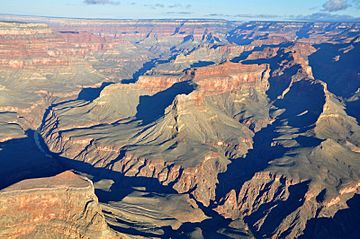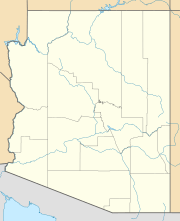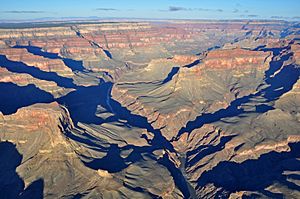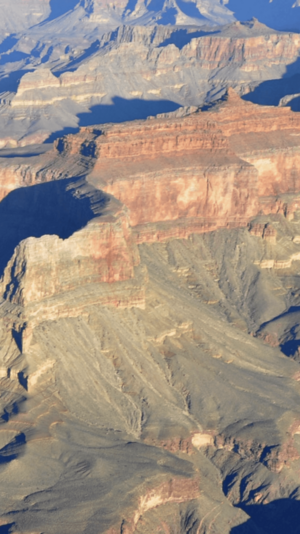Scorpion Ridge facts for kids
Quick facts for kids Scorpion Ridge |
|
|---|---|

Scorpion Ridge
(peak: on platform-ridge of red cliff-former Manakacha Formation, the small remainder cliff of Esplanade Sandstone) |
|
| Highest point | |
| Elevation | 5,832 ft (1,778 m) |
| Prominence | 652 ft (199 m) |
| Parent peak | 6181 |
| Geography | |
| Location | Grand Canyon Coconino County, Arizona. U.S. |
| Topo map | USPS Havasupai Point |
| Geology | |
| Age of rock | Pennsylvanian down to Cambrian and Proterozoic |
| Type of rock | Esplanade Sandstone-(prominence) and Supai Group (4-units) Wescogame, Manakacha, Watahomigi units (massif)-Redwall Limestone Tonto Group _3-Muav Limestone _2-Bright Angel Shale _1-Tapeats Sandstone Vishnu Basement Rocks |
Scorpion Ridge is a cool landform in the Grand Canyon that looks like a scorpion! It's a ridge made of colorful red-orange rocks. This ridge has two "arms" that stretch south towards the Colorado River.
Scorpion Ridge is about 11 miles (18 km) northwest of Grand Canyon Village. It sits near the start of the western part of the Grand Canyon. Its unique position even makes the Colorado River flow in a special way around it.
The main part and arms of Scorpion Ridge stretch about 2.5 miles (4.0 km) north-northeast. Both "arms" are roughly 1.0 mile (1.6 km) long. They curve inward, almost like they are enclosing something. The highest point of Scorpion Ridge is 5,832 feet (1,778 m) tall. This high point is made of a small cliff of Esplanade Sandstone.
What is Scorpion Ridge?
Scorpion Ridge is a prominence. This means it's a peak or hill that stands out from the land around it. Its shape is what gives it its name – it really does look like a scorpion from above!
The ridge is made up of different layers of rock. These layers are part of what geologists call the Supai Group. These rocks give Scorpion Ridge its beautiful red and orange colors.
Grand Canyon Rocks
Scorpion Ridge shows off many of the same rock layers you can see throughout the Grand Canyon. Imagine a giant cake with many different layers – that's kind of like the Grand Canyon!
Around Scorpion Ridge, you can see wide, gentle slopes of a rock called Bright Angel Shale. This shale is often a dull greenish color. Below these slopes are shorter cliffs of Tapeats Sandstone. Underneath all of these layers are the very old rocks of the Vishnu Basement Rocks.
How Scorpion Ridge Formed
The long ridges of Scorpion Ridge are mostly made of a rock layer called the Manakacha Formation. This rock is part of the Supai Group. The Manakacha Formation forms cliffs, but it also creates flat, strong platforms that resist erosion.
A famous example of a strong rock layer in the Grand Canyon is the top of the Redwall Limestone. This layer supports many of the tall peaks and features you see.
The very top of Scorpion Ridge has a special "cap" of rock. This cap is made of Esplanade Sandstone. This sandstone is very strong and protects the softer rocks underneath it from wearing away. You can often find the Esplanade Sandstone on the South Rim of the western Grand Canyon. This is because this sandstone layer gets thicker as you go west in the canyon.




